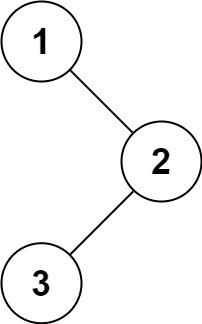LeetCode-in-All
94. Binary Tree Inorder Traversal
Easy
Given the root of a binary tree, return the inorder traversal of its nodes’ values.
Example 1:

Input: root = [1,null,2,3]
Output: [1,3,2]
Example 2:
Input: root = []
Output: []
Example 3:
Input: root = [1]
Output: [1]
Example 4:

Input: root = [1,2]
Output: [2,1]
Example 5:

Input: root = [1,null,2]
Output: [1,2]
Constraints:
- The number of nodes in the tree is in the range
[0, 100]. -100 <= Node.val <= 100
Follow up: Recursive solution is trivial, could you do it iteratively?
To solve the “Binary Tree Inorder Traversal” problem in Java with the Solution class, follow these steps:
- Define a method
inorderTraversalin theSolutionclass that takes the root of a binary tree as input and returns the inorder traversal of its nodes’ values. - Implement an iterative algorithm to perform inorder traversal:
- Initialize an empty list to store the inorder traversal result.
- Initialize a stack to track the nodes during traversal.
- Start with the root node and push it onto the stack.
- While the stack is not empty:
- Traverse down the left subtree by pushing all left child nodes onto the stack.
- Pop the top node from the stack and add its value to the traversal result list.
- Move to the right subtree of the popped node and repeat the process.
- Return the traversal result list.
- Return the inorder traversal result list.
Here’s the implementation of the inorderTraversal method in Java:
import java.util.ArrayList;
import java.util.List;
import java.util.Stack;
class Solution {
public List<Integer> inorderTraversal(TreeNode root) {
List<Integer> inorder = new ArrayList<>();
Stack<TreeNode> stack = new Stack<>();
TreeNode curr = root;
while (curr != null || !stack.isEmpty()) {
while (curr != null) {
stack.push(curr);
curr = curr.left;
}
curr = stack.pop();
inorder.add(curr.val);
curr = curr.right;
}
return inorder;
}
}
This implementation performs an iterative inorder traversal of the binary tree using a stack, with a time complexity of O(N), where N is the number of nodes in the tree.

